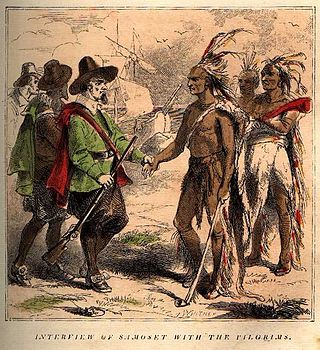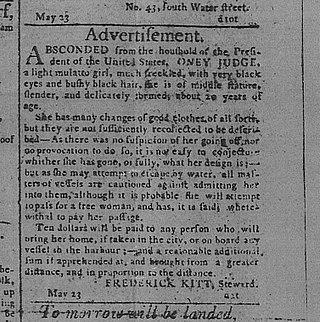
The Pennsylvania Dutch, also known as Pennsylvania Germans, are an ethnic group native to Pennsylvania and other American states. They descend from Germans who settled in Pennsylvania during the 17th, 18th and 19th centuries, primarily from the Palatinate, and other German-speaking areas, including Baden-Württemberg, Hesse, Saxony, and Rhineland in Germany, the Netherlands, Switzerland, and France's Alsace-Lorraine region.

Slavery in the colonial history of the United States, from 1526 to 1776, developed from complex factors, and researchers have proposed several theories to explain the development of the institution of slavery and of the slave trade. Slavery strongly correlated with the European colonies' demand for labor, especially for the labor-intensive plantation economies of the sugar colonies in the Caribbean and South America, operated by Great Britain, France, Spain, Portugal, and the Dutch Republic.

The colonial history of the United States covers the history of European colonization of North America from the early 17th century until the incorporation of the Thirteen Colonies into the United States after the Revolutionary War. In the late 16th century, England, Kingdom of France, Spanish Empire, and the Dutch Republic launched major colonization programs in North America. The death rate was very high among early immigrants, and some early attempts disappeared altogether, such as the English Lost Colony of Roanoke. Nevertheless, successful colonies were established within several decades.

Indentured servitude is a form of labor in which a person is contracted to work without salary for a specific number of years. The contract, called an "indenture", may be entered "voluntarily" for purported eventual compensation or debt repayment, or it may be imposed "involuntarily" as a judicial punishment. Historically, it has been used to pay for apprenticeships, typically when an apprentice agreed to work for free for a master tradesman to learn a trade. Later it was also used as a way for a person to pay the cost of transportation to colonies in the Americas.

The Middle Colonies were a subset of the Thirteen Colonies in British America, located between the New England Colonies and the Southern Colonies. Along with the Chesapeake Colonies, this area now roughly makes up the Mid-Atlantic states.

Coolie is a pejorative term used for low-wage labourers, typically of Indian or Chinese descent.
Indo-Guyanese or Indian-Guyanese, are people of Indian origin who are Guyanese nationals tracing their ancestry to India and the wider subcontinent. They are the descendants of indentured servants and settlers who migrated from India beginning in 1838, and continuing during the British Raj.
A headright refers to a legal grant of land given to settlers during the period of European colonization in the Americas. A "headright" includes both the grant of land and the owner that claims the land. The person who has a right to the land is the one who paid to transport people to a colony. Headrights are most notable for their role in the expansion of the Thirteen Colonies; the Virginia Company gave headrights to settlers, and the Plymouth Company followed suit. The headright system was used in several colonies, including Maryland, Georgia, North Carolina and South Carolina. Most headrights were for 1 to 1,000 acres (4.0 km2) of land, and were granted to those who were willing to cross the Atlantic and help populate the colonies. Headrights were granted to anyone who would pay for the transportation costs of an indentured laborer. These land grants consisted of 50 acres (0.20 km2) for someone newly moving to the area and 100 acres (0.40 km2) for people previously living in the area. By ensuring the landowning masters had legal ownership of all land acquired, the indentured laborers after their indenture period had passed had little opportunity to procure their own land. This kept a large portion of the citizens of the Thirteen Colonies poor and led to tensions between the laborers and the landowners.

The Chesapeake Colonies were the Colony and Dominion of Virginia, later the Commonwealth of Virginia, and Province of Maryland, later Maryland, both colonies located in British America and centered on the Chesapeake Bay. Settlements of the Chesapeake region grew slowly due to diseases such as malaria. Most of these settlers were male immigrants from England who died soon after their arrival. Due to the majority of men, eligible women did not remain single for long. The native-born population eventually became immune to the Chesapeake diseases and these colonies were able to continue through all the hardships.
The Indian indenture system was a system of indentured servitude, by which more than 1.6 million Indians were transported to labour in European colonies, as a substitute for slave labor, following the abolition of the trade in the early 19th century. The system expanded after the abolition of slavery in the British Empire in 1833, in the French colonies in 1848, and in the Dutch Empire in 1863. British Indian indentureship lasted till the 1920s. This resulted in the development of a large Indian diaspora in the Caribbean, Natal, East Africa, Réunion, Mauritius, Sri Lanka, Malaysia, Myanmar, to Fiji, as well as the growth of Indo-Caribbean, Indo-African, Indo-Fijian, Indo-Malaysian, and Indo-Singaporean populations.

John Casor, a servant in Northampton County in the Virginia Colony, in 1655 became the first person of African descent and second person in the Thirteen Colonies to be declared as a slave for life as a result of a civil suit. In 1662, the Virginia Colony passed a law incorporating the principle of partus sequitur ventrem, ruling that children of enslaved mothers would be born into slavery, regardless of their father's race or status. This was in contradiction to English common law for English subjects, which based a child's status on that of the father. In 1699 the Virginia House of Burgesses passed a law deporting all free black people. But many new families of free black people continued to be formed during the colonial years by the close relationships among the working class.

When the Dutch and Swedes established colonies in the Delaware Valley of what is now Pennsylvania, in North America, they quickly imported enslaved Africans for labor; the Dutch also transported them south from their colony of New Netherland. Enslavement was documented in this area as early as 1639. William Penn and the colonists who settled in Pennsylvania tolerated slavery. Still, the English Quakers and later German immigrants were among the first to speak out against it. Many colonial Methodists and Baptists also opposed it on religious grounds. During the Great Awakening of the late 18th century, their preachers urged slaveholders to free people their slaves. High British tariffs in the 18th century discouraged the importation of additional slaves, and encouraged the use of white indentured servants and free labor.
During the British colonization of North America, the Thirteen Colonies provided England with much needed money and resources. However, the culture of the Southern and Chesapeake Colonies was different from that of the Northern and Middle Colonies and from that of their common British colonial power.

The 1688 Germantown Quaker Petition Against Slavery was the first protest against enslavement of Africans made by a religious body in the Thirteen Colonies. Francis Daniel Pastorius authored the petition; he and three other Quakers living in Germantown, Pennsylvania, signed it on behalf of the Germantown Meeting of the Religious Society of Friends. Clearly a highly controversial document, Friends forwarded it up the hierarchical chain of their administrative structure—monthly, quarterly, and yearly meetings—without either approving or rejecting it. The petition effectively disappeared for 150 years into Philadelphia Yearly Meeting's capacious archives; but upon rediscovery in 1844 by Philadelphia antiquarian Nathan Kite, latter-day abolitionists published it in 1844 in The Friend, in support of their antislavery agitation.

Indentured servitude in Pennsylvania (1682-1820s): The institution of indentured servitude has a significant place in the history of labor in Pennsylvania. From the founding of the colony (1681/2) to the early post-revolution period (1820s), indentured servants contributed considerably to the development of agriculture and various industries in Pennsylvania. Moreover, Pennsylvania itself has a notable place in the broader history of indentured servitude in North America. As Cheesman Herrick stated, "This system of labor was more important to Pennsylvania than it was to any other colony or state; it continued longer in Pennsylvania than elsewhere."
The credit-ticket system was a form of emigration prevalent in the mid to late nineteenth century, in which brokers advanced the cost of the passage to workers and retained control over their services until they repaid their debt in full. It generally refers to the immigration of Chinese to California, but migrants to Hawaii, British Columbia, and Australia participated in a similar process. Controversy exists over whether or not the credit-ticket system was actually voluntary. The association of Chinese laborers with involuntary contract labor during a time in which it was illegal exacerbated the public's anti-Asian sentiments. However, because of the lack of documentation regarding the credit-ticket system, it is difficult to prove whether or not Chinese laborers were truly free agents.
Indentured servitude in continental North America began in the Colony of Virginia in 1609. Initially created as means of funding voyages for European workers to the New World, the institution dwindled over time as the labor force was replaced with enslaved Africans. Servitude became a central institution in the economy and society of many parts of colonial British America. Abbot Emerson Smith, a leading historian of indentured servitude during the colonial period, estimated that between one-half and two-thirds of all white immigrants to the British colonies between the Puritan migration of the 1630s and the American Revolution came under indenture. For the colony of Virginia, specifically, more than two-thirds of all white immigrants arrived as indentured servants or transported convict bond servants.

Indentured servitude in British America was the prominent system of labor in the British American colonies until it was eventually supplanted by slavery. During its time, the system was so prominent that more than half of all immigrants to British colonies south of New England were white servants, and that nearly half of total white immigration to the Thirteen Colonies came under indenture. By the beginning of the American Revolutionary War in 1775, only 2 to 3 percent of the colonial labor force was composed of indentured servants.
Gottlieb Mittelberger was a German author, schoolmaster, organist, and Lutheran pastor. He was best known for his work Journey to Pennsylvania (1756). Mittelberger's travelogue provides a firsthand historic account of the misery and exploitation of German immigrants during the US colonial period. In his work, he tries to convince his fellow Germans not to immigrate to the American colonies, as the forfeiture of freedom, cost of money, lack of health, and loss of life are too exorbitant to risk and sacrifice. Although never an indentured servant, Mittelberger's written testament is one of several surviving historic works describing the hardships of the redemption system.

Irish indentured servants were Irish people who became indentured servants in territories under the control of the British Empire, such as the British West Indies, British North America and later Australia.











